Overview
In the fast-paced world of tech startups, many founders grapple with the challenge of maintaining operational efficiency while striving for innovation. This struggle often leads to feelings of overwhelm and frustration, as daily tasks can easily overshadow the creative vision that sparked their journey. It's crucial to recognize that this is a common experience, one that many in the startup community share.
The significance of the BAU (Business As Usual) acronym cannot be overstated. By embracing a structured approach to BAU practices, startups can find a balance between routine tasks and innovative pursuits. This balance not only fosters resilience but also enhances customer engagement in an increasingly competitive landscape. Imagine a startup where daily operations seamlessly support creative endeavors, allowing founders to focus on what they love most—bringing their ideas to life.
As you navigate this journey, remember that establishing effective branding strategies through BAU can be a nurturing solution. It empowers you to create a stable foundation, enabling your startup to thrive amidst challenges. By sharing your experiences and seeking support from others in the community, you can cultivate a network of encouragement and understanding. Together, we can foster an environment where innovation flourishes alongside operational excellence.
Introduction
In the competitive realm of technology startups, many founders grapple with the challenge of maintaining daily operations while fostering innovation. This struggle can often feel overwhelming, as the pressure to adapt in a rapidly changing market weighs heavily on their shoulders.
The concept of "Business As Usual" (BAU) emerges as a crucial framework for sustaining operations and driving growth during such times. By understanding and implementing BAU principles, startups can streamline their daily activities, enhance branding strategies, and improve customer engagement.
However, the real question is: how can startups effectively integrate BAU practices to foster resilience and adaptability? This article delves into seven key insights that illuminate the transformative power of the BAU acronym for tech startups, offering strategies that not only address these challenges but also empower founders to thrive in an ever-evolving landscape.
Together, let's explore how embracing BAU can lead to a more balanced and successful journey.
RNO1: Transforming Branding Strategies with BAU Principles
In the fast-paced world of technology, many startups struggle with establishing a consistent brand presence. This challenge can lead to feelings of uncertainty and frustration, especially when competing against well-established players. Without a , it’s easy for new enterprises to feel lost in the noise, risking not just visibility but also the trust of potential customers.
At RNO1, we understand these concerns deeply. By embracing a BAU acronym approach, we prioritize routine branding activities that empower technology enterprises to create a strong market presence. This nurturing method allows brands to remain agile, adapting to evolving trends while cultivating trust and recognition among their target audiences. Imagine the peace of mind that comes from knowing your branding efforts are consistent and effective.
Successful technology companies that have adopted these principles often share transformative stories about their journeys. They highlight how regular engagement and adherence to brand guidelines can significantly enhance market visibility and foster customer loyalty. As industry specialists emphasize, a strong commitment to branding is crucial for new businesses seeking to differentiate themselves in a crowded marketplace.
Ultimately, the impact of routine branding efforts extends far beyond mere visibility; it lays a solid foundation for long-term growth and resilience in the ever-changing technology landscape. At RNO1, we are here to support you every step of the way, nurturing your brand's journey toward sustained success and helping you thrive amidst the challenges.
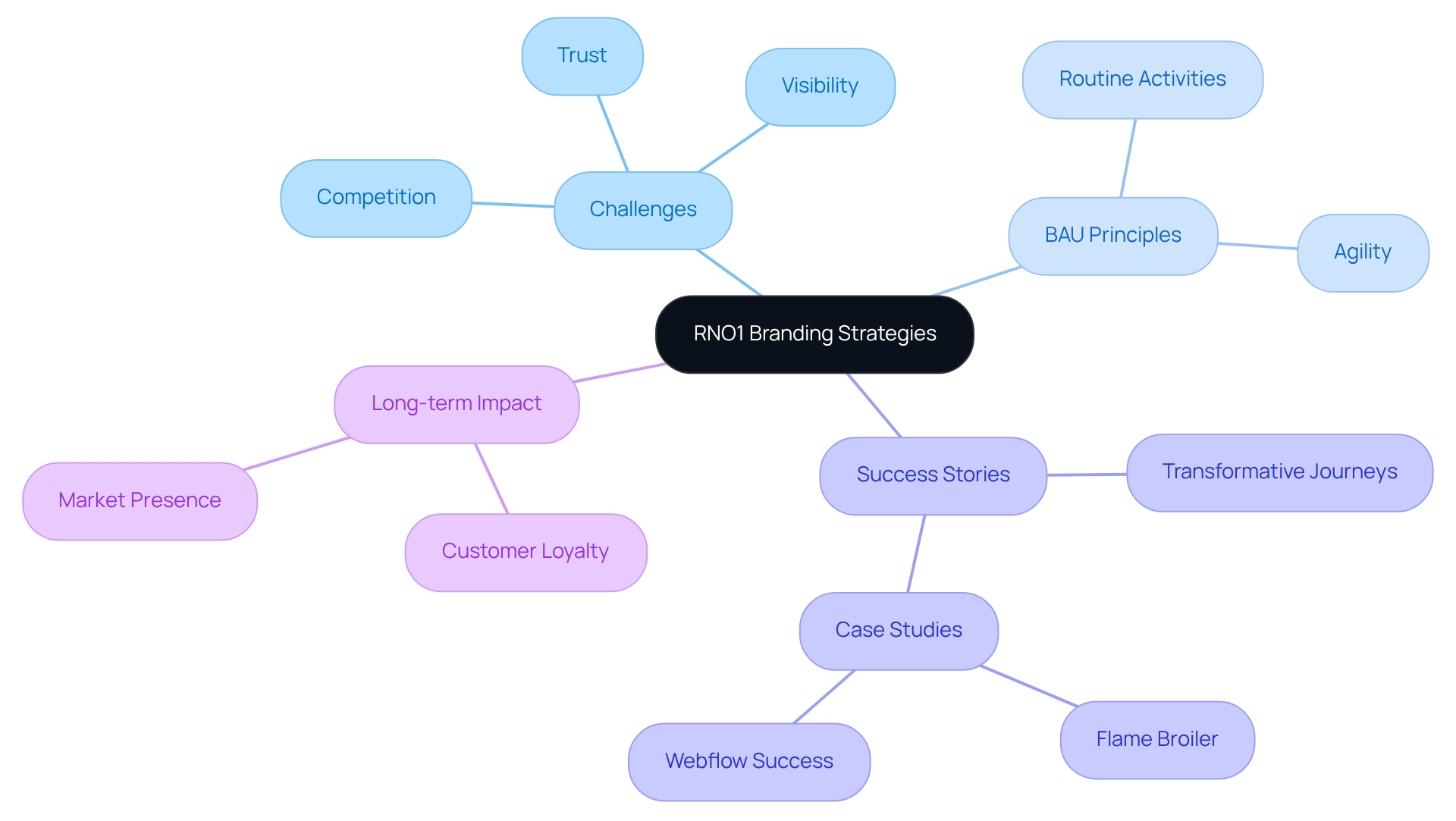
Understanding BAU: Definition and Importance for Startups
The BAU acronym, which means Business As Usual, represents the essential operations and activities that organizations undertake to sustain their business. For technology ventures, grasping the BAU acronym is crucial, as it encompasses the routine tasks that foster stability and consistency. As Zoltan Patai insightfully notes, the 'BAU acronym' stands for 'Business as usual' tasks, which are the most basic actions required to operate a business on a daily basis, such as delivering a product, issuing an invoice, or responding to customer inquiries. By establishing a robust framework defined by the BAU acronym, new ventures can dedicate their energy to innovation while ensuring that vital operations flow seamlessly.
However, many founders face the challenge of balancing innovation with the demands of daily business activities. Statistics reveal that prioritizing the BAU acronym on management's agenda can significantly enhance long-term business results, improving operational efficiency and helping to meet strategic goals. Yet, as projects can introduce inefficiencies and scope creep, complicating the journey. As Ben MacCorquodale wisely states, "By clearly defining what constitutes a project versus the BAU acronym, using governance mechanisms to classify work, and staying vigilant for warning signs, companies can ensure each effort gets the right treatment."
Implementing a structured framework based on the BAU acronym allows new ventures to create a positive flywheel effect, where improvements in routine operations liberate resources for strategic initiatives. This balance is vital, enabling technology companies to respond to market demands while preserving the reliability of their core functions. Moreover, automating BAU tasks can elevate customer satisfaction and positively influence revenues and costs. Ultimately, a well-defined approach known as the BAU acronym not only supports daily operations but also positions new ventures for sustainable growth in a competitive landscape, nurturing their journey toward success.
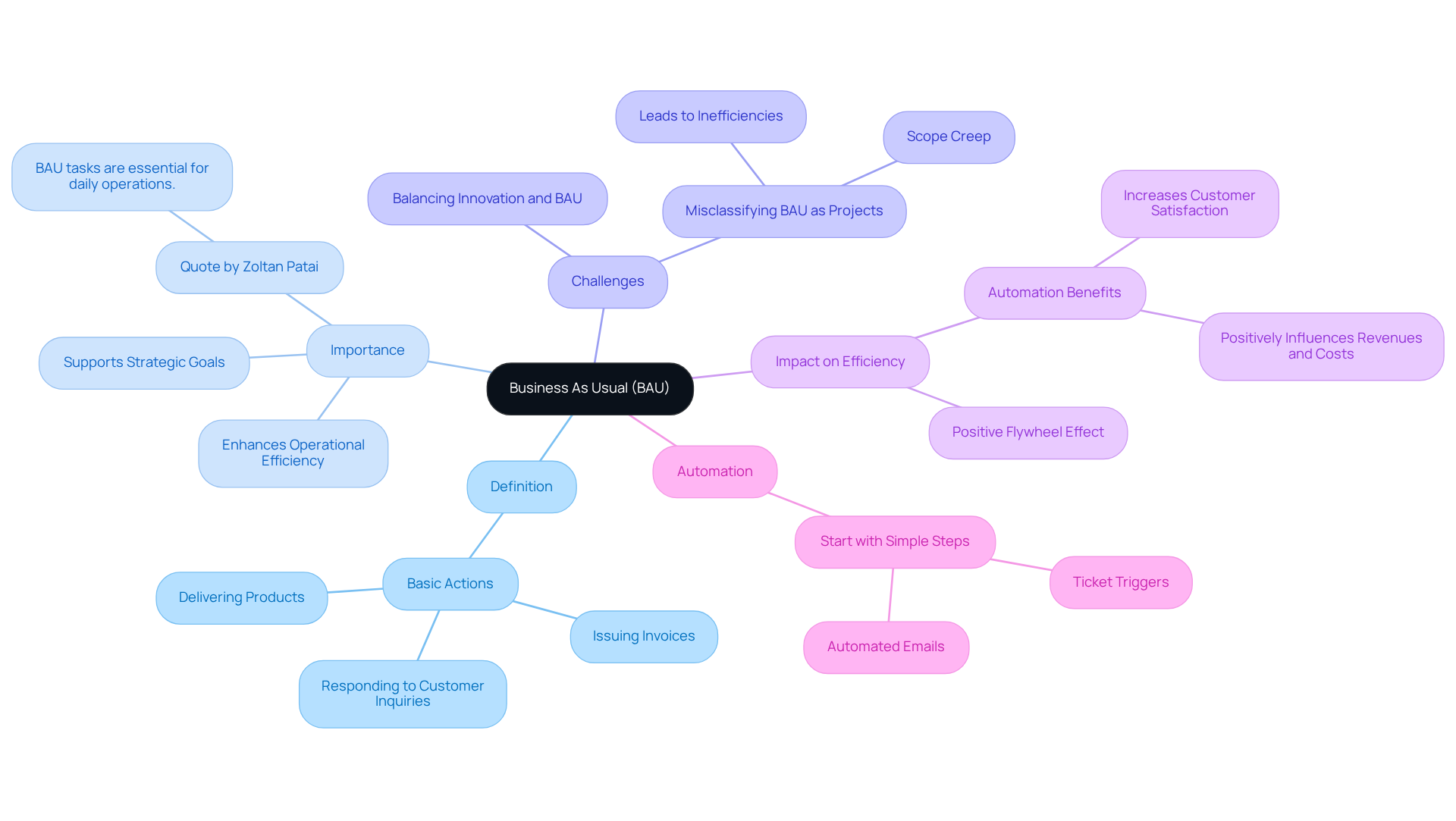
The Role of BAU in Ensuring Operational Efficiency
For new technology companies, the BAU acronym can often represent a daunting challenge, as operational efficiency seems just out of reach. Many founders grapple with the complexities of standardizing processes and routines, leading to frustration and a sense of overwhelm. This struggle can result in errors and hinder productivity, making it difficult to focus on what truly matters—strategic initiatives that drive growth. At RNO1, we understand this pain all too well, and we’re here to help.
When teams are bogged down by day-to-day tasks, it can feel like innovation is stifled. However, effective practices associated with the BAU acronym allow teams to not only manage their daily responsibilities but also to thrive. By creating a supportive framework, businesses can ensure that quality is maintained while freeing up valuable resources. RNO1 exemplifies this nurturing approach by being hyper-focused on delivering real results from day one, aligning BAU practices with strategic goals.
Organizations that prioritize BAU foster resilience, enabling them to adapt swiftly to changing market demands. Imagine a world where operational issues are resolved efficiently, allowing creativity and innovation to flourish. By implementing structured incident management processes, we can help new businesses navigate challenges without losing sight of their vision.
Ultimately, a known as the BAU acronym supports daily operations and lays the groundwork for sustainable growth and success. At RNO1, we are committed to preventing scope creep through clear communication and collaborative project management. Together, we can create an environment where your startup not only survives but thrives, reflecting our shared commitment to excellence and community.
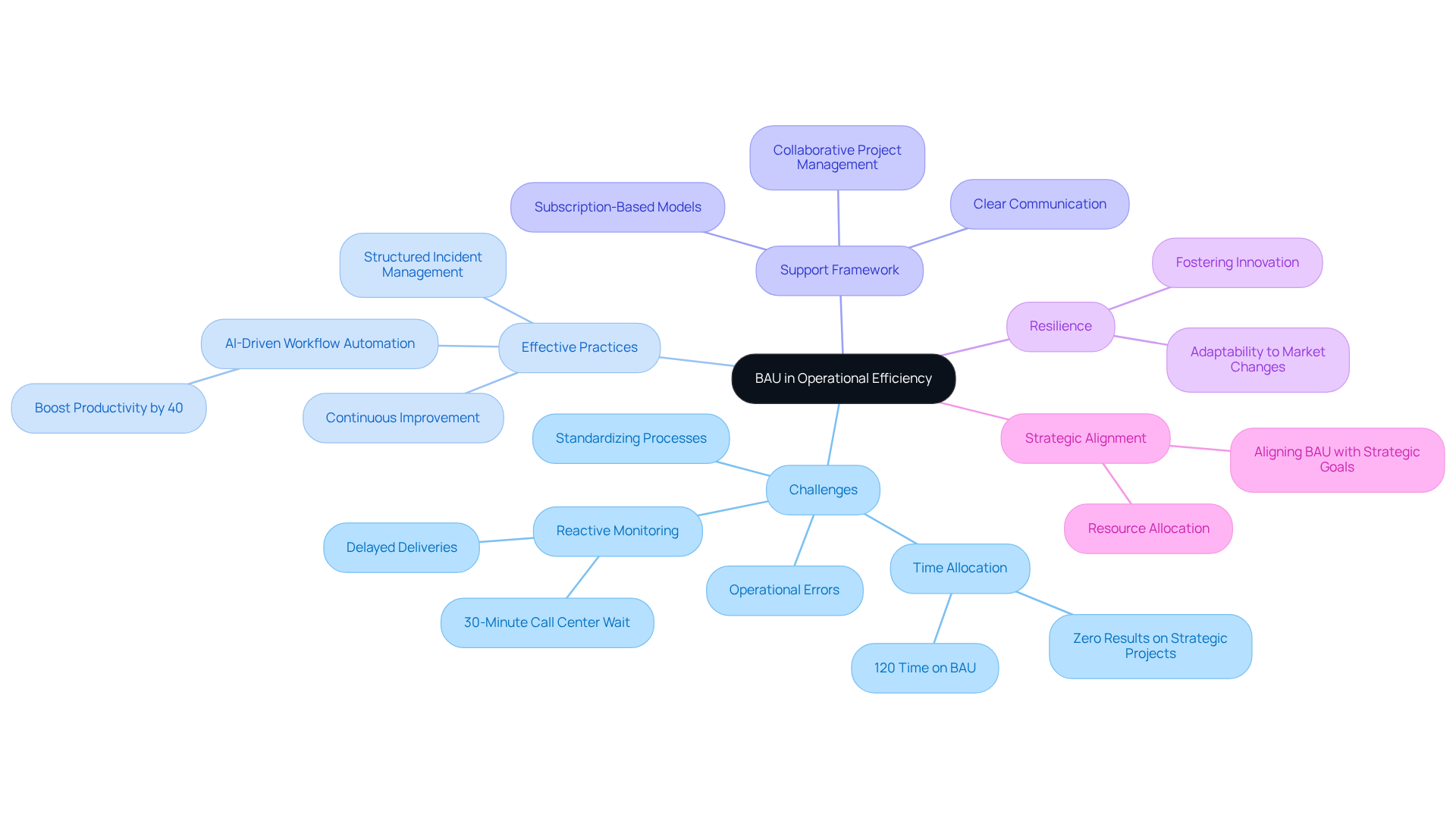
Enhancing Customer Engagement Through Effective BAU Practices
For tech startups, implementing effective practices denoted by the BAU acronym is essential to enhance client engagement. Many founders struggle with establishing consistent communication channels, which can lead to weakened relationships with clients. Imagine the frustration of losing clients due to a lack of regular interactions.
Routine follow-ups, personalized marketing efforts, and responsive client service are not just tasks; they are vital components that contribute to a positive client experience. Research indicates that firms with strong omnichannel engagement strategies retain 89% of their clients, compared to only 33% for those with less effective approaches. This disparity highlights the importance of nurturing these relationships.
Moreover, consider this: 75% of consumers are likely to return to a business that offers outstanding service, even after an error. This statistic underscores the power of prioritizing client satisfaction. By focusing on these practices, new businesses can not only enhance client satisfaction but also cultivate loyalty, paving the way for long-term success in a competitive environment.
Successful technology ventures demonstrate that a commitment to ongoing communication and proactive involvement, which aligns with the principles of the BAU acronym, can lead to improved client relationships and higher retention rates. Together, let’s embrace these strategies to .
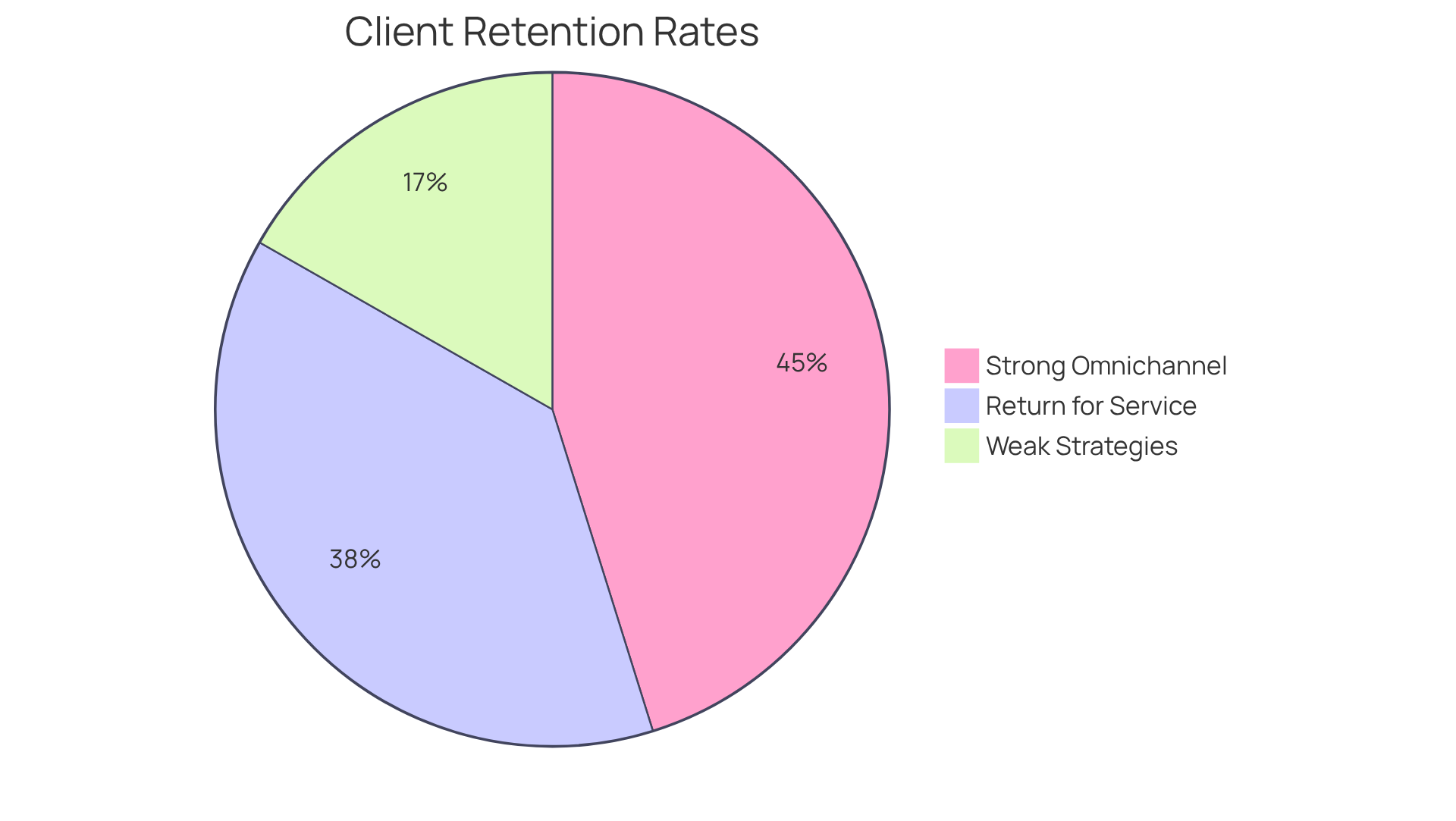
Adapting BAU Strategies to Evolving Market Conditions
For technology ventures, adapting strategies defined by the BAU acronym to evolving market conditions is not just important; it’s essential for survival. Many founders face the daunting challenge of keeping pace with rapid changes, which can feel overwhelming. This requires a proactive approach to regularly review and in alignment with market trends, customer preferences, and technological advancements.
As Julie Choo wisely states, "When the TOM is designed to deliver in phases, with a good flexible roadmap... an enterprise is in the position to successfully navigate its journey to deliver the outcomes in the TOM and the benefits sought."
By fostering agility within the BAU acronym practices, new businesses can effectively capitalize on emerging opportunities while also mitigating the risks associated with market fluctuations. The capacity to pivot and react quickly to changes not only improves operational efficiency but also empowers new businesses to thrive in a competitive environment.
As emphasized by industry specialists, sustaining a flexible framework known as the BAU acronym is crucial for maneuvering through the intricacies of the tech ecosystem, ensuring that new businesses remain resilient and innovative amidst disruption. Additionally, many new ventures typically focus on survival planning for a duration of 1 to 18 months, highlighting the necessity of adjusting their BAU acronym strategies.
This adaptability is illustrated in case studies where new ventures implementing a Target Operating Model (TOM) have secured investor confidence, demonstrating the practical application of these concepts. Remember, you are not alone in this journey; embracing flexibility can open doors to new possibilities and foster a supportive community that thrives together.
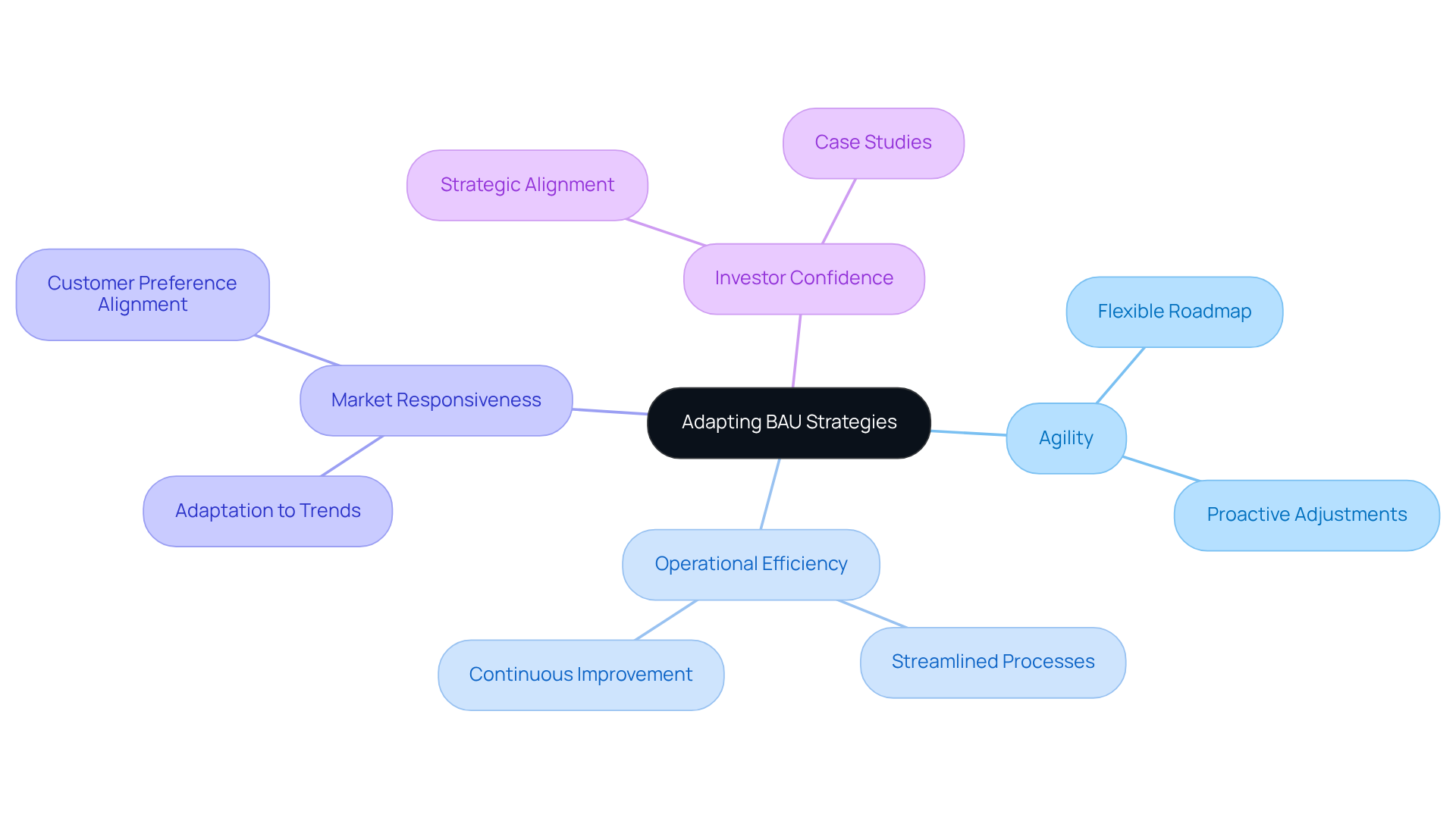
Outsourcing BAU: A Strategic Move for Tech Startups
Outsourcing tasks associated with the BAU acronym often presents a significant challenge for many technology companies striving to enhance efficiency while managing tight budgets. It can feel overwhelming to juggle routine operations like customer support, accounting, or IT maintenance, especially for new businesses eager to innovate and grow. This struggle can lead to feelings of frustration and fatigue, as founders find themselves stretched thin, unable to focus on what truly matters—their core competencies and the creative ideas that sparked their journey.
Imagine the relief of being able to delegate these essential yet time-consuming tasks to external providers. By doing so, you not only conserve valuable time and resources but also gain access to specialized expertise that may not be available within your own team. This approach allows you to redirect your energy towards innovation and strategic growth, fostering a healthier work environment and a more sustainable business model.
At RNO1, we understand the emotional and professional challenges you face. We’re here to support you in navigating this journey, offering that empower you to thrive. Together, we can help you focus on what you do best, while ensuring that your operational needs are met with care and expertise.
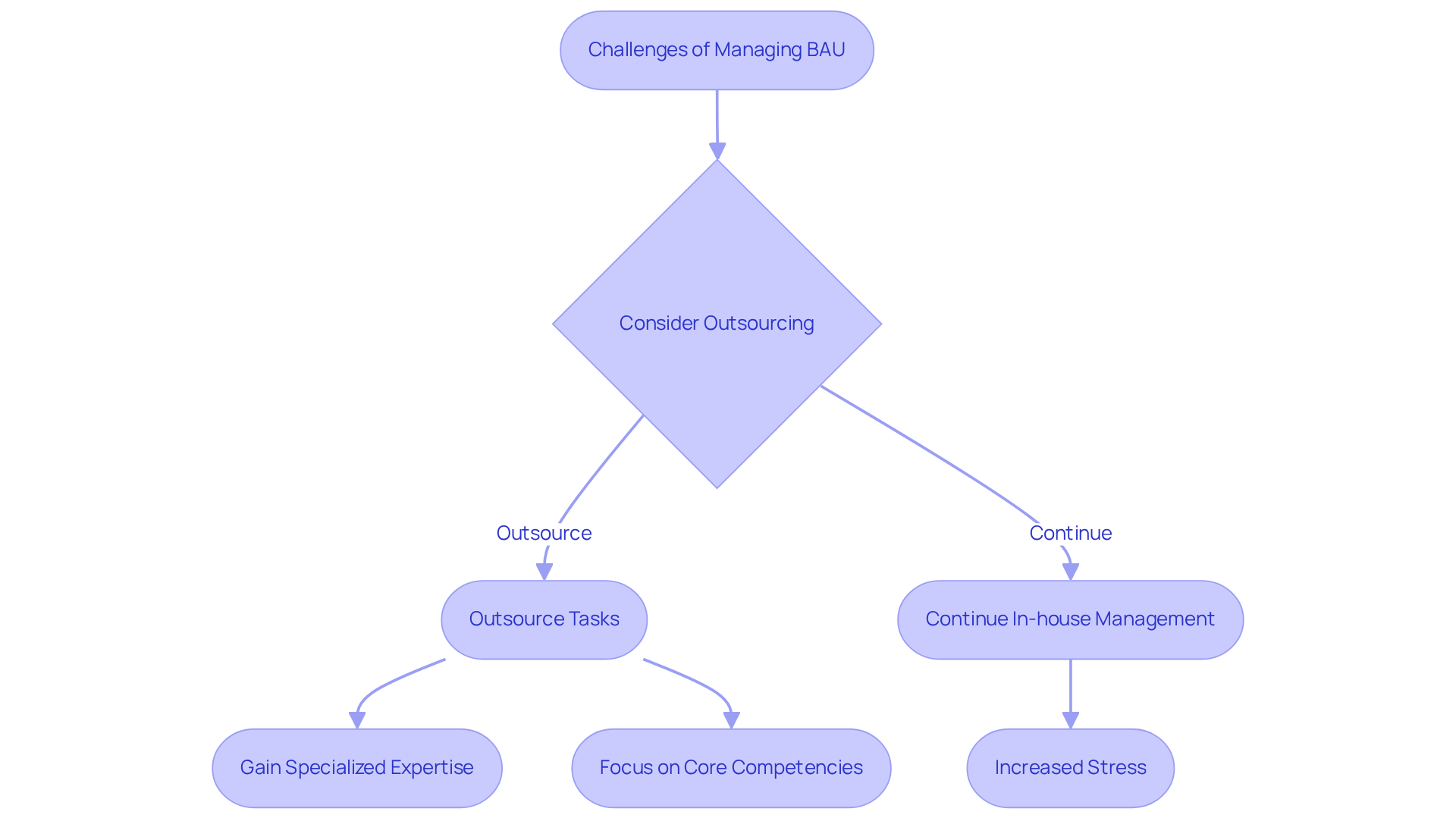
Building the Right Team Skillsets for BAU Success
Building the right team skillsets is essential for the success of business-as-usual (BAU acronym) practices in technology ventures. Many startups face the challenge of identifying the key competencies needed for routine operations, which can be daunting. Without a well-prepared team, the complexities of the BAU acronym can feel overwhelming, leading to operational issues that can hinder growth. This emphasizes the importance of investing in training and development.
By fostering a culture of continuous learning, you can encourage your team members to enhance their skills in vital areas such as:
Imagine a well-equipped team navigating these complexities while driving innovation forward. The success associated with the BAU acronym is often measured by ongoing enhancement and sustaining operational efficiency, making it essential for new businesses like yours to prioritize training. Neglecting BAU can create a ripple effect of challenges, but with a supportive approach to skill development, your team will be better equipped to handle the ambiguity and conflict that may arise in project environments.
Remember, nurturing your team's growth is not just an investment in skills; it's an investment in the future of your business.
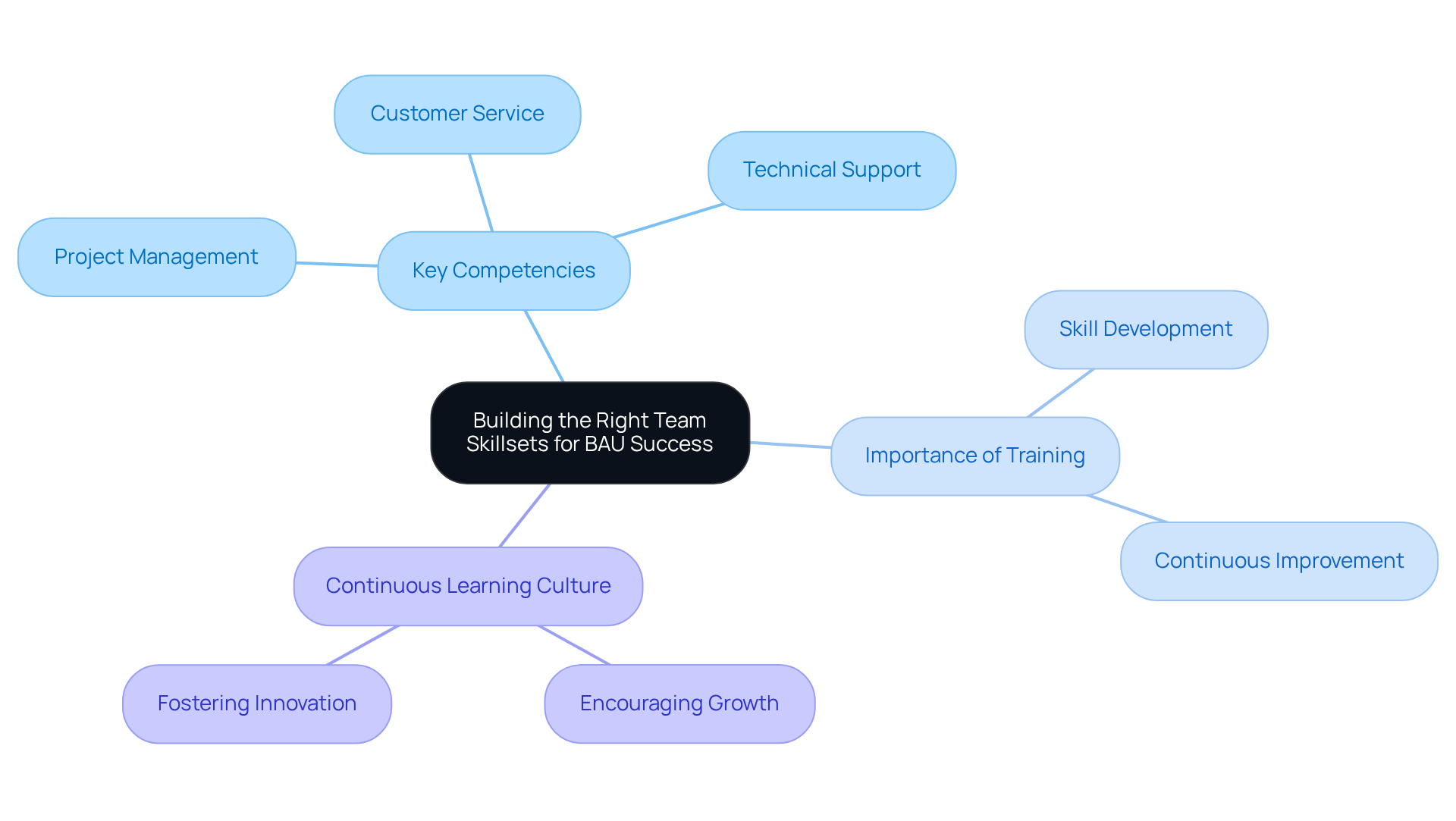
Case Studies: Successful BAU Implementations in Tech Startups
Exploring case studies of successful implementations of the BAU acronym in technology ventures sheds light on the challenges many founders face. For example, RNO1's strategic rebranding of the Founder's Haven brand is a heartfelt attempt to enhance the experience for modern founders. This illustrates how customized strategies, represented by the BAU acronym, can truly lead to operational success.
Consider a startup that streamlined its support processes through BAU practices; it saw a remarkable boost in client satisfaction, with studies showing that companies employing structured BAU acronym strategies can witness satisfaction improvements of up to 20%. This is significant, especially when we recognize that purchasers dedicate 54% of their time reviewing case studies before making purchasing decisions. It underscores the importance of effective practices associated with the BAU acronym in shaping those crucial buyer choices.
Another inspiring example is Breakwater Kitchens, which experienced a 7% growth in sales after automating manual tasks and integrating social media management through Thryv. This transformation not only sped up innovation cycles but also enhanced overall productivity, demonstrating how RNO1's performance marketing expertise can nurture growth in the competitive tech landscape.
Moreover, customer testimonials are essential in boosting the credibility and relatability of case studies, further highlighting the transformative potential of effective practices represented by the BAU acronym in fostering customer loyalty.
We invite you to reflect on these insights and consider how RNO1 can in navigating these challenges.
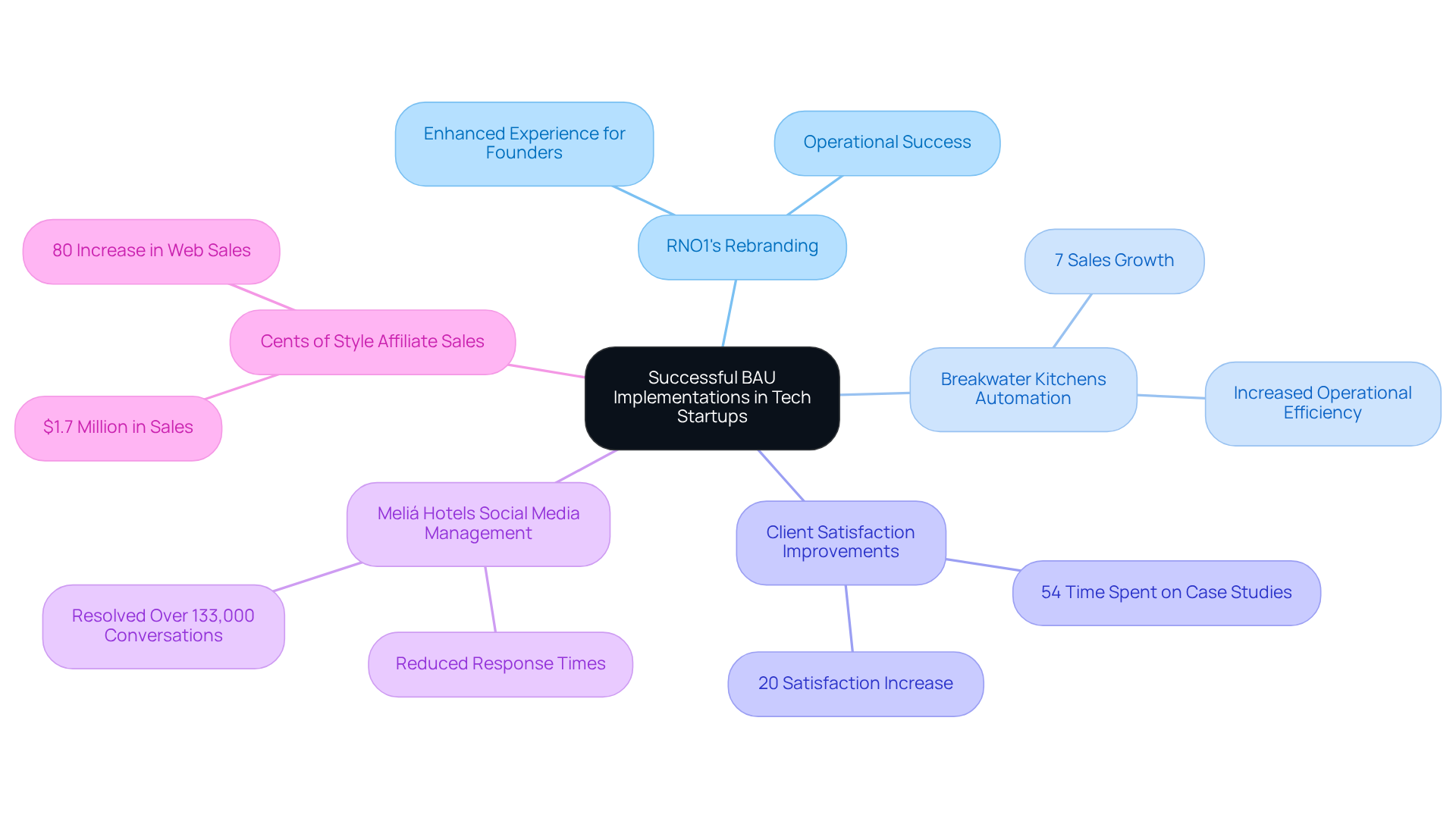
Challenges in Implementing BAU: What Tech Startups Should Avoid
Tech companies often encounter significant challenges when it comes to executing practices referred to by the BAU acronym. One common issue is the tendency to overlook regular reviews of BAU processes, which can lead to stagnation and operational inefficiencies. This can be particularly frustrating, especially when team members grow resistant to change, feeling comfortable with their established routines. It's important to recognize that this resistance is not uncommon; statistics reveal that 70% of technology enterprises face similar hurdles when attempting to adjust their workflows. This highlights the pressing need for proactive management and support.
To navigate these challenges effectively, it's essential for new ventures to foster a and continuous improvement. By doing so, practices associated with the BAU acronym can evolve alongside the business, empowering teams to embrace change with confidence. This not only enhances operational efficiency but also nurtures a spirit of innovation within the organization. Furthermore, providing clear criteria and educating staff on the distinctions between projects and BAU can help prevent misclassification and confusion, ultimately supporting more effective implementation.
As we reflect on these experiences, let’s remember that we’re not alone in this journey. Many founders share similar struggles, and together, we can cultivate an environment where change is not just accepted, but embraced. This supportive approach can make a world of difference in overcoming the obstacles we face.
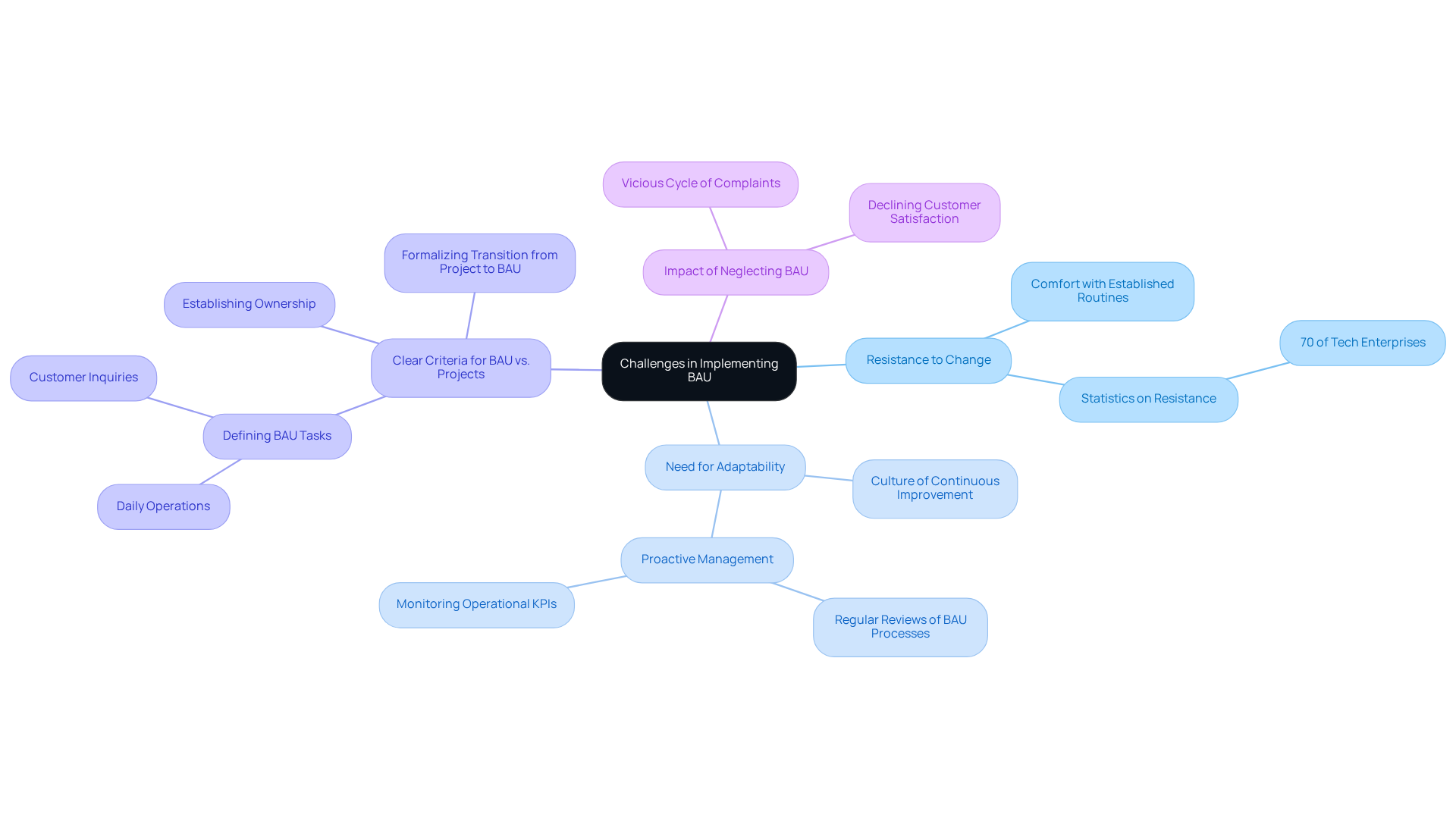
Future Trends in BAU: What Tech Startups Need to Know
In today's rapidly changing business landscape, many technology companies find themselves grappling with the need to adapt to new trends in practices associated with the BAU acronym. The challenge lies in the increasing integration of automation and AI into daily operations, which, while enhancing efficiency, can also lead to concerns about job security and the future of work. It’s important to acknowledge that less than 5% of jobs can be fully automated, yet approximately 60% of roles have at least 30% of their activities that can be automated. This reveals a significant potential for transformation in job roles, which can be daunting for many. By 2035, we anticipate that automation will fundamentally reshape these roles, allowing human workers to focus on more complex tasks that require creativity and emotional intelligence. As Jeff Bezos insightfully notes, AI has the potential to create a 'much wealthier civilization' and improve the quality of work, highlighting the positive implications of these technologies.
Moreover, the shift towards data-driven decision-making is becoming increasingly vital. Startups that harness performance metrics to inform their strategies can make timely adjustments, ensuring they remain competitive in a dynamic market. This transition can feel overwhelming, but as organizations adopt , they also free up human resources for tasks that require unique problem-solving abilities. This shift ultimately fosters a more innovative work environment. For instance, the case study on 'AI as a Co-Pilot in the Workforce' illustrates how AI can enhance productivity by supporting human workers rather than replacing them. By embracing these trends, tech startups can position themselves for sustained success and navigate the complexities of the modern business landscape with confidence and resilience.

Conclusion
Understanding the significance of the BAU acronym—Business As Usual—is essential for tech startups striving for sustainable growth and operational efficiency. Many founders grapple with the challenge of maintaining a consistent brand presence while fostering innovation. By integrating BAU principles into their daily practices, startups can enhance customer engagement and ensure that routine tasks do not hinder their creative pursuits. Balancing these elements is crucial in navigating the complexities of the competitive tech landscape.
Throughout this journey, we’ve shared key insights that emphasize the importance of a structured approach to BAU. Transforming branding strategies, ensuring operational efficiency, adapting to market changes, and outsourcing functions are all vital aspects that shape a startup's path. The successful implementation of BAU practices can lead to improved client relationships, increased productivity, and the agility to respond swiftly to evolving market demands.
As technology continues to advance, embracing future trends associated with BAU will be paramount for startups. This includes leveraging automation and data-driven decision-making to enhance efficiency while prioritizing human creativity and emotional intelligence. By focusing on these strategies, tech startups can not only survive but thrive, fostering a resilient community that adapts to challenges and embraces opportunities for growth. Together, let’s cultivate an environment where innovation flourishes alongside operational excellence.
Frequently Asked Questions
What is the BAU acronym and why is it important for startups?
BAU stands for "Business As Usual," representing the essential operations and activities that organizations undertake to sustain their business. For startups, understanding BAU is crucial as it encompasses routine tasks that foster stability and consistency, allowing them to focus on innovation while ensuring vital operations run smoothly.
How can routine branding activities benefit technology startups?
Routine branding activities help technology startups create a strong market presence by enabling them to remain agile and adapt to evolving trends. This consistent approach cultivates trust and recognition among target audiences, which is essential for differentiating themselves in a crowded marketplace.
What challenges do founders face when balancing innovation with daily operations?
Founders often struggle to balance the demands of daily business activities with the need for innovation. Misclassifying routine tasks as projects can lead to inefficiencies and complicate operations, making it difficult to achieve strategic goals.
How does prioritizing BAU influence long-term business results?
Prioritizing BAU on management's agenda can enhance long-term business results by improving operational efficiency and helping to meet strategic goals. A structured framework based on BAU allows companies to create a positive flywheel effect, freeing up resources for strategic initiatives.
What practices can help new technology companies improve operational efficiency?
Implementing effective BAU practices, such as standardizing processes and routines, can help new technology companies manage daily responsibilities while fostering innovation. A supportive framework ensures quality is maintained and resources are available for growth.
How can RNO1 assist startups in their branding and operational strategies?
RNO1 provides support by helping startups embrace BAU principles, ensuring that routine branding efforts are consistent and effective. They also focus on aligning BAU practices with strategic goals to enhance operational efficiency and foster resilience in adapting to market demands.




